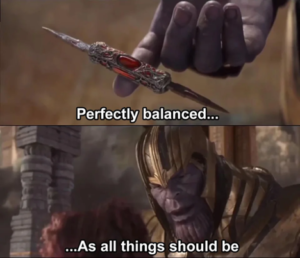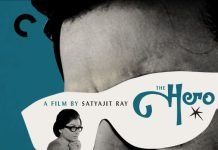(Drafted by Lokesh Vyas, Angad Makkar and Akshat Agrawal -contributors to IPRMENTLAW. Special thanks to Anushree Rauta and the whole IPRMENTLAW team for their beautiful balancing ideas.)
Note: The article offers a lot of paradoxes to understand IP and the role of fair use in it, so read it carefully and patiently, it might not give you novel information but it will give you some interesting angles/ideas to ponder upon. By the time, you reach the conclusion, you are very likely to have more questions about your existing answers and more answers to your existing questions. Please note that this might be written from one keyboard but the ideas are from man key-bods. So…
Let’s brag the Balance
Balance is bizarre! Isn’t it? We don’t know all the sides and still want to balance it. Trust me! it does not always have TWO sides, let’s look beyond the binary (of balancing two sides) and ask what is the balance? And why is it craved everywhere – in marriage, in body, in the economy, in relationships, in trade, in Chai (tea – a balance of various ingredients), or even in an academic atmosphere? Maybe because it maximizes utility? But again ‘what’ is utility – hedonic, welfare, happiness, preferential…? Is it subjective? Maybe! Is it contextual? Maybe! Then what?
Let’s look at it this way!
We read (not limiting it to a textual reading) so that we can write (not limiting it to literary scribbling but rather understanding it as an expression)? But why do we write? So that others can read and then write (maybe)? Or understand maybe? Or get a perspective maybe? Or give a perspective maybe? It means what you are reading today is because someone else wanted you to read it and if you decide to write tomorrow, it will be the same as what ‘someone’ had envisioned while writing. Isn’t it circular and pre-planned? Maybe! But who planned it? Nobody knows. But still, in every case, reading and writing will go one way or the other. Why?
Is it balanced (or baffled)? Maybe!
Let’s delve into I-P-R and look for the balance (if any). So begin! Why is IP created? Many reasons – may be fame, money, prestige, enjoyment…anything. Fine! But why is it “provided”? Simply because more people can create? Simply to ensure that people are not forced to shift to other marginal sources of revenue? Simply to ensure that those who express and only prefer to express, can sustain the cruel society, while expressing? So the idea is to evangelize ‘non-creators’ into ‘creators’ and sustain them- not instantly though, but at some point in time. This can be corroborated with the objective of IP enshrined under Article 7 of TRIPS, which states:
“The protection and enforcement of intellectual property rights should contribute to the promotion of technological innovation and to the transfer and dissemination of technology, to the mutual advantage of producers and users of technological knowledge and in a manner conducive to social and economic welfare, and to a balance of rights and obligations”
You might not get a direct hint at turning ‘non-creators into creators’, but you can clearly see the emphasis placed upon the consequential objective of causing public good or public interest. Here, it unfolds two interesting ideas. Firstly, IP is for ‘others’ (non-creators/to be creators/public) and not for the ‘self (creators)’. Had it been ‘self’-centered, the objective would have been protecting the creator without any larger goal to achieve. But as you see, it goes beyond that. Secondly, (read carefully) will the objective be fulfilled the moment others get benefited from the creations, or does it go further? Based on our personal understanding, it goes further to the extent where ‘others’ start feeling the sense of becoming ‘self’, or (in other words) incentivized to contribute to ‘others’ by stepping in the shoes of ‘self’. It is so because it’s not a one-time game that starts with creating and ends with the public good – if it were so, it would exhaust too soon and the benefit would be temporary (it may not even last for more than two-three generations). But it’s not so the story goes – a New (from the existing public) person comes, creates, and causes creativity in others… Please remember! Immortality is too fictional (or spiritual?) to gain, so there will surely be new creators who replace (or co-exist) with the old ones and add creations to society. Let me present the kernel of the story: creators create for people and then someday someone from public step up and become ‘creator’ and starts creating – the circle goes. Does it go forever? Maybe!
Interestingly, we are back to the same idea – balance. But now who is creating this balance this time? The creators who we also referred to as the ‘self’? Or the public who we called ‘others’ or to be creators? Or both? Ask me and I’d shout the ‘balance’ of both. Creators have many reasons to create, similarly, the public has many ways to enjoy, creation is optional for them? So who should get the credit? WTO, WIPO, IP- ‘Right’ system, USA, UK, God, Universe, or Buddha? Nobody? Everybody?
Let’s light it again!
Ask me and I’d give the credit to everybody/thing, but I will start with the IP-Right system – the one which is balanced. Notably, the word ‘balanced’ specifically refers to the balance between the rights of creators and users. Speaking statutorily (i.e., restricting myself to Copyright Act, 1957), the balance is between Section 14 and Section 52 which read as ‘meaning of copyright’ and ‘certain acts not to be an infringement of copyright’ respectively. The former enlists the rights of authors (though they can be waived under Section 17) and the latter lays down a list of acts that can prevail over Section 14. Section 14 as also argued here is subject to Section 52 and cannot be invoked in derogation of it. Similarly, Section 52 is not an absolute right in every sense but a right used for certain purposes. In the ideal scenario, both confirm the presence of each other. Section 14 gives economic incentives to people to create work and Section 52 is a tool used by users to jump Section 14 and use copyrighted works, especially when these incentive-faced rights hamper the larger interests of social “good”. Thus, neither of them is too important to irk another. Both are needed for the fruitful functioning of copyright law.
Wait! Read it again! Yes, we are back to basics. Yet again, balance is key.
Pertinently, both Section 14 and Section 52 stem from Article 19 of the Constitution of India, which is the freedom of expression – thus, neither of them is subservient to the other. Recollect the above debate, if Section 14 is the territory of ‘creators’ or ‘self’, then Section 52 is the territory of ‘others’ and you know the history. So, let’s not juxtapose them with the help of ‘versus’, rather consider them two parts of the same which, though can’t look at each other, at the same time can’t deny the existence of each other. These are rights not to be pitted against each other, but ones which share a parasitic relationship- in order to foster effective cultural/informational dialogues and environmentalism. But it’s not the (happy?) end; let’s dig deeper into the second territory i.e. Section 52, and see how it’s interpreted and actually effectuated in India.

Image source: here
So…
The lead-in language to Section 52 of the Act reads as follows, “following acts shall not constitute an infringement of copyright“. So you can reasonably infer that this provision aims to list down an exhaustive list of exceptions to infringement of copyright (as provided for under Section 51). But wait! This is not true. Due to the usage of the words ‘fair dealing’ under Sections, 52(1)(a) and 52(1)(b), the whole provision has sometimes erroneously been viewed as laying down an overarching fair dealing exception under Indian copyright law. There is a need for greater clarity in the application of the fair dealing’ doctrine, which, pursuant to Section 52, should come into play only when a literary, dramatic, musical, or artistic work is utilized for (i) private use, including research, (ii) criticism or review, or (iii) for the purpose of reporting of current events.
Separately, the Act does not lay down criteria for the assessment of ‘fair dealing’. Why do we conflate fair dealing with Section 52 then? Well, although the courts have correctly harmonized the idea of “fair dealing” within the Act, yet interpreters tend to be extremely confused. What is the confusion about? Section 52 is NOT EQUAL to fair dealing. Transposing the term fair dealing, when referring to all or any of the provisions of this section is a grave mistake. Why so? Well, context matters. A close reading of section 52, and all the subsections therein, clearly shows that the requirement of a fairness analysis is limited only to sections 52(1)(a) and 52(1)(b). Nowhere else, is the use required to be fair. Put other way, any use of a “work” subjected to copyright which, whether fulfilling the four factor test of fair dealing/ fair use or not, falls within the statutory provisions of 52(1)(c)- 52(1)(za), there is no need to even get into this question of “fair dealing/ fair use” or a fairness analysis.
Only in sections 52(1)(a) and 52(1)(b) has the statute and the legislature explicitly provided for the requirement of the use to be “fair”. In all the other sections, as long as the work falls within the mentioned criteria of use, even if it is unfair, the same is “deemed” to be fair and permissible. The Delhi High Court in the India TV case or the Kerala High Court in Civic Chandran (which also raises questions about a parody exception under Indian copyright law) have seemingly relied upon the fair dealing factors (equivalent to the US fair use factors, with some variation), to ascertain whether a work is covered by section 52(1)(a) and no other sub-section. On the other hand, the Delhi High Court in the DU Photocopying case (as it is colloquially referred to) rejected the application of the four fair use factors in context of section 52(1)(i) and only paid heed to the language of section 52(1)(i) and whether the use was fitting therein, irrespective of it being fair or not. So why the confusion? Well, we guess that maybe the landlord- type (shamelessly plagiarizing Brian Frye because well- Plagiarism is not a crime) tendencies of copyright owners make them feel that only their entitlements are fair and nothing else. But that’s when we come in and ask the copyright cops – where is the balance?
A happy “use” and “public interest” week to all “balance” in copyright aficionados here. Cheers!! (*raise them glasses*).
More article from the authors: Lokesh Vyas (here), Angad Makkar (here), Akshat Agarwal (here).
Image source: here


















